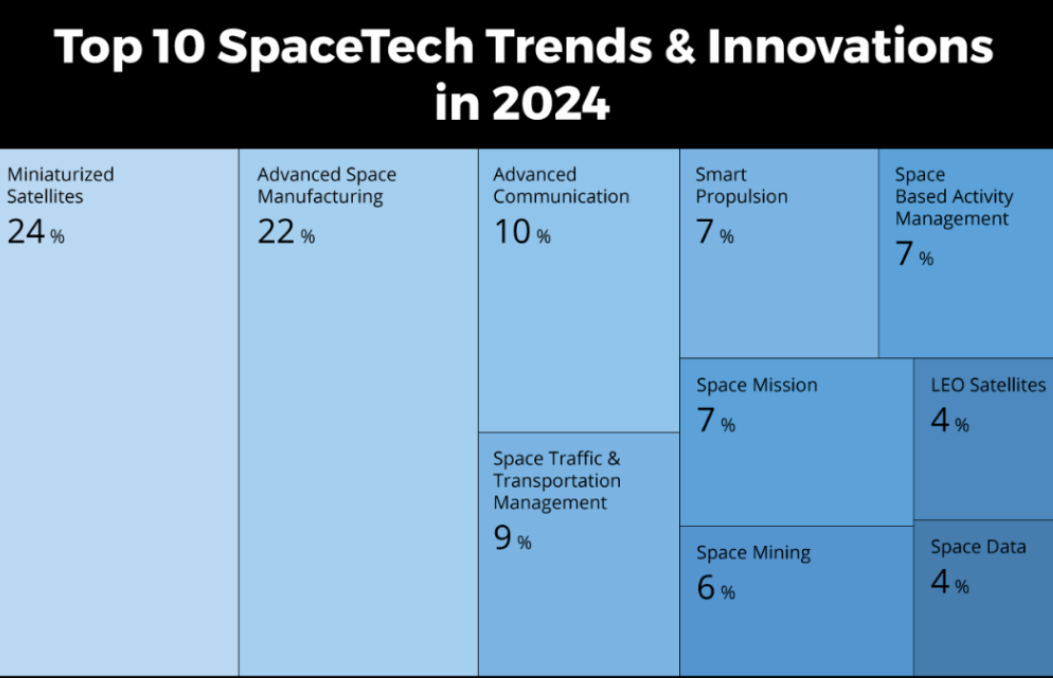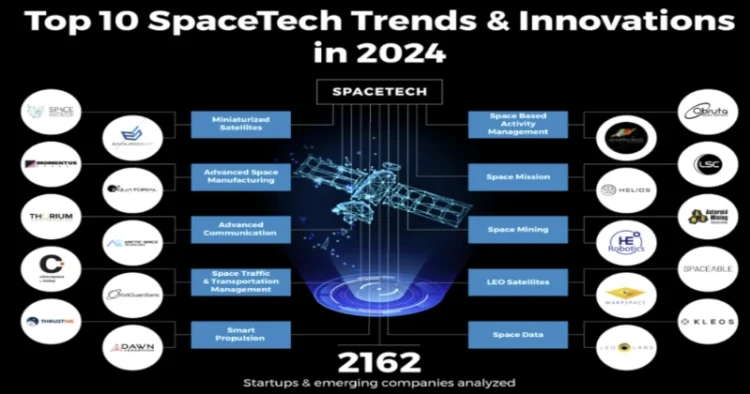The space industry is utilising emerging technologies, including 5G, advanced satellite systems, 3D printing, big data, and quantum computing, to upgrade and scale operations in space. Many services, such as weather forecasting, remote sensing, global positioning system (GPS) navigation, satellite television, and long-distance communication, rely on space infrastructure. Moreover, new space industry trends, like smart propulsion, space robotics, and space traffic management are also gaining traction. Together with increasing private investment in the industry, startups develop technologies to ease movement, operations, and communications between Earth and space.
Top 10 New Space Technologies in 2024
1. Small Satellites
Small satellites have become a leading trend in SpaceTech, especially in 2024. Their miniaturisation allows for cost-effective designs, and advancements in industrial technology enable mass production. Startups are developing small satellites that perform tasks typically challenging for larger satellites. These include proprietary wireless communications networks, scientific observation, data gathering, and Earth monitoring using GPS.
2. Advanced Space Manufacturing
Space manufacturing is embracing cutting-edge technologies like advanced robotics, 3D printing, and light-based manufacturing to enhance space products and services. These innovations are driving the development of large space structures, reusable launch vehicles, space shuttles, and advanced satellite sensors. Automation plays a crucial role in the space industry, particularly for long-term exploration and missions. Consequently, startups are offering solutions specifically designed for the space industry’s needs.
3. Novel Space Communication Systems
At its simplest, space communications rely on two things – a transmitter and a receiver. A transmitter encodes a message onto electromagnetic waves. These waves then flow through space toward the receiver. However, recent developments in space communication go beyond transmitters and receivers to offer advanced communication in space through high-capacity antennae, ground stations, and LEO satellites.
4. Space Traffic Management
Of all the man-made LEO satellites, a vast majority of them are now space junk. This includes rocket thrusters, derelict satellites, and most of all, tiny fragments of debris from collisions and explosions. All of this debris threatens the future of space exploration and travel. To tackle this situation, startups are developing feasible solutions for debris retrieval and space traffic management.
5. Smart Propulsion
In-space propulsion is an important subsystem for satellite constellations. Given the costs and environmental impact that come with space missions, companies seek ways to ensure the sustainability of these missions. Hence, global startups and scaleups are developing several solutions ranging from electric, green, and water-based propulsion to iodine-based propulsion systems to enable the next generation of clean rockets in space.
6. Space Activity Management
The increasing number of space missions demands efficient coordination of various space missions and activities. As a result, startups are offering advanced space activity management solutions. The development of advanced mission control software enables real-time monitoring and management of spacecraft and satellites. The use of AI-driven analytics for predicting and mitigating potential orbital conflicts enhances the safety of space operations.
7. Space Missions
Space exploration addresses the fundamental questions about our universe and the history of our solar system. Space missions also widen the scientific and technological advancements while inspiring the future generation of students, teachers, and researchers worldwide.
8. Space Mining
The mining of celestial bodies is shifting from science-fiction (Sci-Fi) to reality. Asteroid mining by private individuals and companies through advancements in space cameras and satellites aid in the precise location of asteroids. Once located, these celestial bodies can be used to extract minerals such as platinum, gold, iron, or even water. The economic incentive for space mining is evident and analysts predict that it could potentially translate to a billion-dollar industry.
9. Low-Earth Orbit Satellites
A low-earth orbit is relatively close to Earth’s surface and is normally at an altitude of less than 1000 km but could be as low as 160 km above Earth. Also, LEO satellites do not always follow a particular path around Earth. This means that there are more routes for satellites in the LEO. This makes it a feasible target for space companies. To this end, startups are developing relevant solutions and techniques to deal with LEO-related challenges, including communication systems and data management.
10. Space Data
LEO satellites and multi-satellite constellations are increasingly in use for communication, spying, earth monitoring, and other imaging applications. With large volumes of data from these satellites, there is a need to process, treat, analyse, and manage the information. Startups tap into SpaceTech data are using AI, blockchain, and big data to offer secure data solutions for the space industry.
Impact of the Top 10 Space Industry Trends in 2024
The Tree Map below illustrates the impact of the Top 10 SpaceTech Trends in 2024. Startups & scaleups are building small satellites like CubeSats and NanoSats to reduce launch costs. Companies are also developing reusable launch vehicles to further reduce the cost of launching rockets into space. Fast and secure communications is becoming a reality by incorporating satellites advancements in hardware like antennae, transmitters, and receivers.

With an expected growth in space traffic, startups are creating feasible solutions for space travel and traffic management, as well as junk and debris removal. Finally, low-earth orbit (LEO) satellites, along with big data & analytics, play a crucial role in the success of future space exploration and missions.




















Comments